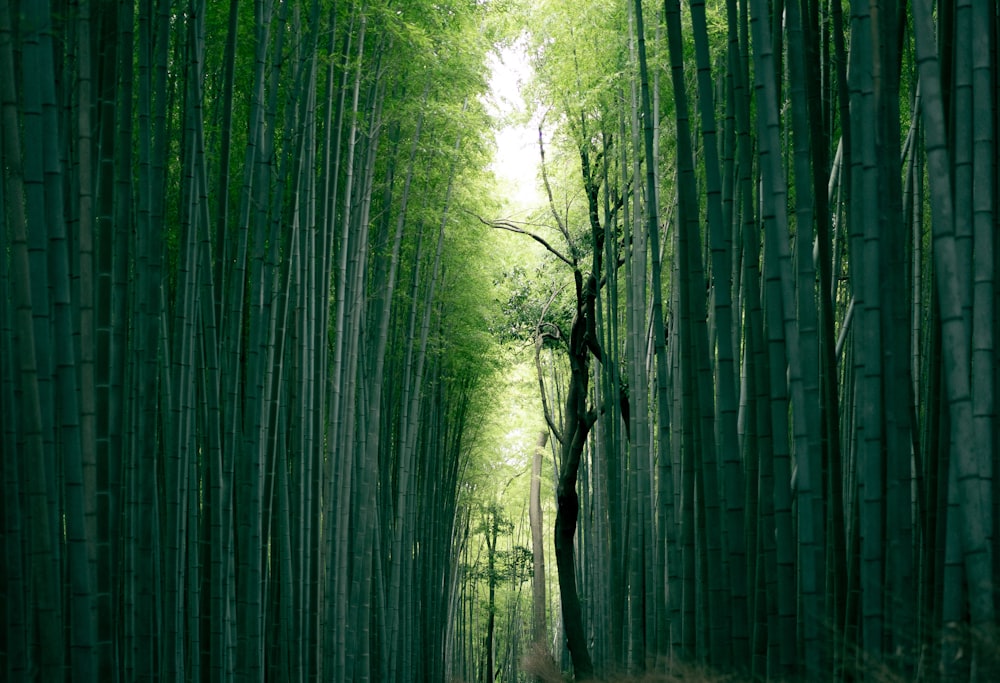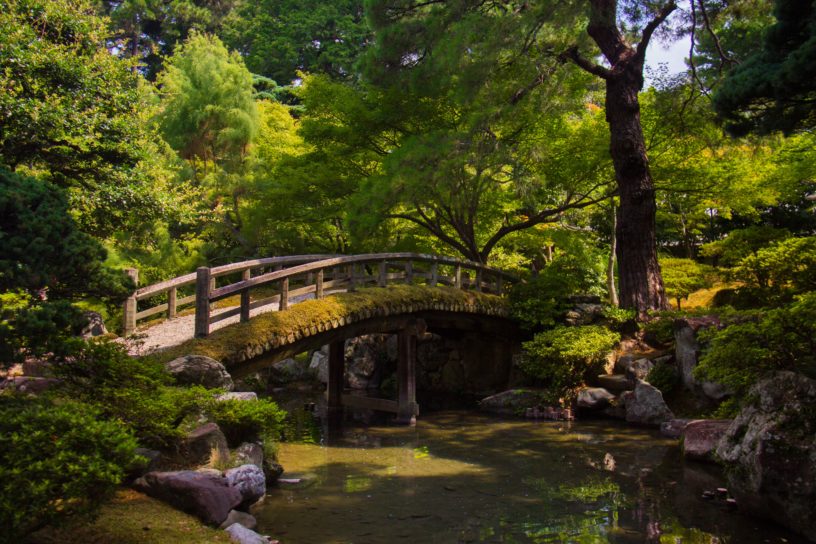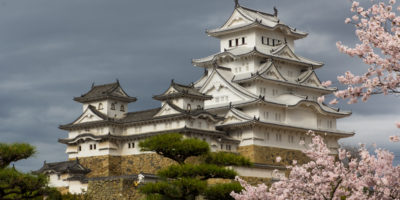
Temple in the middle of the forest in Japan. Photo by Samuel Berner- Unsplash
10 Most beautiful Forests in Japan
In terms of forest-land ratio, Japan is one of the most forested countries in the world (forest area in relation to land area). It comes in second only to Finland, where the forest land ratio is nearly 74 percent, the highest in the world.
Sweden comes in second with 67 percent, followed by South Korea with 64 percent. Brazil is almost at 60 percent. Germany, Switzerland, the United States, and Canada all have 30 percent to 35 percent.
Other countries have fared much worse, with China scoring 22 percent, Australia scoring 17 percent, and the United Kingdom scoring only 13 percent!
The main cause for low ratio involves natural environmental attributes, as well as forest destruction and urban growth. Whatever the case may be, the fact remains that Japan has something to provide that so many other countries do not have, or do not have any longer – a lush green forest with a high biodiversity.
Let that sink in: forest covers two-thirds of Japan’s land area!
1. The Aokigahara Forest
At an elevation of 1,000 meters, the Aokigahara Forest is located to the east of Lake Saiko. It covers about 30 million square meters. The forest is thought to have formed after Mt. Fuji’s volcanic eruption about 1,200 years ago, when new trees sprouted from cooled lava.
The thick forest is a National Natural Treasure and is part of Fuji Hakone Izu National Park. Despite the fact that the soil is only about 10 centimetres thick, the forest is a sea of trees, including evergreen conifers like Japanese cypress and broadleaf trees like Mongolian oak, Fuji cherry, and maple trees.
It also serves as a home for small animals, birds, and insects, as well as bats who live in the lava caves. You can hike with ease if you join a guided tour led by registered Fuji-Kawaguchiko guides who are well-versed in the forest’s ecology.
The Saiko shuyu circular bus takes 40 minutes from Kawaguchiko Station on the Fuji Kyuko Line. Take the bus to the Saiko-komoriana stop.
Address: Narusawa, Fujikawaguchiko, Minamitsuru District, Yamanashi 401-0300, Japan
2. Owakudani

Thick and long bamboo trees. Photo by Juniper Photon- Unsplash
Mt. Kamiyama erupted about 3,000 years ago, forming Owakudani. It is an active volcano that still emits sulphurous gas and vapour at temperatures of 100°C. The rough rocks emit white smoke and a sulfurous odor, indicating the power of nature.
At 1,040 meters above sea level, you can see Mt. Fuji and Japan’s North Alps, as well as Yokohama’s Landmark Tower and Rainbow Bridge on a clear day. Taking the Hakone Ropeway provides a view of Owakudani.
Owakudani eggs with a deep black shell are a specialty, created by the chemical reaction of geothermal heat and volcanic gas.
Izu Hakone Bus departs from Odawara Station on the JR and Odakyu Lines, or from Hakone Yumoto Station. Take the Hakone Tozan Cablecar or Hakone Ropeway from Gora Station.
Address: Sengokuhara, Hakone, Ashigarashimo District, Kanagawa 250-0631, Japan
3. The Koajiro-no-Mori Forest
The Koajiro-no-Mori Forest is located on the Miura Peninsula in Kanagawa Prefecture and serves as a water catchment area for the Ura-no-kawa River, which flows through the valley in the centre.
A continuous stretch of land from the forest, marsh, and mudflat to the sea has been preserved in its natural state and is a highly valuable resource. Numerous ecosystems are being produced from a various of living organisms, such as rare species.
This forest is represented by red-clawed crabs (Chiromantes haematocheir), which involve an environment of a forest, river, and sea to survive. A red-clawed crab is known as a “forest crab” because it can live away from water. As a result, you can spot one in the forest.
From late May to early June, the forest is also open to the public for firefly observation, and you can see two types of Japanese fireflies, Luciola cruciata and Luciola lateralis. As several zones of the Koajiro-no-Mori Forest have been left untouched, some animals may be dangerous.
When visiting, it is best to wear a long-sleeved shirt, long trousers, and walking shoes. It is a 30-minute walk on the Keikyu Express from Misakiguchi Station or a 5-minute walk from the Hikibashi Terminal bus stop if you take a bus from Misakiguchi Station.
Address: Koajiro Misakimachi, Miura, Kanagawa 238-0225, Japan
4. The Iroha-zaka Slopes

Temple in the middle of the forest in Japan. Photo by Samuel Berner- Unsplash
The Iroha-zaka Slopes lead to Lake Chuzenji and Kegon Falls, two popular tourist attractions in Nikko. Daiichi Iroha-zaka (the first, for going down) and Daini Iroha-zaka (the second, for going up) have 48 hairpin turns; the “Iroha” in the names comes from a song used to memorize Japanese characters.
The angle of inclination is 440 meters, making the slopes an excellent vantage point for viewing Nikko’s natural beauty. The most common season is fall, when trees progressively begin to change colour from the north side, forming a completely new scene in front of you.
Buses depart from both JR Nikko Station and Tobu Nikko Station on the Tobu Line, and the journey to the summit of the Iroha-zaka Slopes takes approximately 40 minutes.
Address: Japan, 〒321-1445 Tochigi Prefecture, Nikko, 細尾町
5. Yakushima Kagoshima Forest
Yakushima has Japan’s most ancient forest, with trees up to 7,000 years old, and is thought to have inspired the Studio Ghibli film Princess Mononoke. Following substantial logging during the Edo period, the forest has since bounced back and is now shielded as a national park.
Yakusugi (a combination of the island’s name and the Japanese word for cedar) trees over 1,000 years old can be found throughout the island. Since it is a subtropical island, there is a lot of rain and a lot of mist in the forest. Learn more about Yakushima exploration.
Address: Japan, 〒891-4311 Kagoshima, Kumage District, Yakushima, Anbo, 0
6. Iriomote’s mangroves
Ishigaki and its nearby islands are subtropical, especially the uncultivated island of Iriomote, which is entirely different from the rest of Japan. The island, which is mostly undeveloped, has a rich natural resources that can be explored by kayak, stand-up paddleboard, hiking, or swimming—ideal for adventurers.
There are several tour guides on the island who can take you on half-day or full-day excursions to see the sights. You can also take a water-buffalo cart to Yubu Island, a subtropical garden with hundreds of tree and flower variations.
Address: Komi, Taketomi, Yaeyama District, Okinawa 907-1432, Japan
7. The Arashiyama Sagano bamboo forest

Travellers hiking up the steps in the forest. Photo by Zhipeng Ya- Unsplash
The Arashiyama Sagano bamboo forest, one of Japan’s most photographed locations, is a sight to behold. It’s brilliantly relaxing, with colourful sunshine and swinging trees.
They can grow to be up to 20 meters tall, and looking up can be quite surreal, particularly when there is a breeze. The breathtaking aesthetic is enough to make you stop and stare.
There is much to discover here, including Nonomiya Shrine and Tenryuji Temple, and the path is only 200 meters long, so you can take your time and enjoy the relaxed environment.
Address: Sagatenryuji Susukinobabacho, Ukyo Ward, Kyoto, 616-8385, Japan
8. Rikugien Gardens
This is one for the imaginative: Rikugien, also spelled Rikugi-en, translates as “Garden of the Six Principles of Poetry.” It was constructed many centuries ago and includes a pond, a hill, and trees, as well as a beautiful formal Japanese garden with a bamboo grove. (You can also get your sakura fix if you time your trip correctly.)
Address: 6 Chome-16-3 Honkomagome, Bunkyo City, Tokyo 113-0021, Japan
9. Suzume-no Oyado Ryokuchi Park
Aside from trendy Nakameguro, Meguro is home to Suzume-no Oyado Ryokuchi Park, which features a 200-year-old bamboo grove and a refurbished classic Japanese home. These are both open to tourists, and it is widely acknowledged that this is one of Tokyo’s most impressive bamboo forests. The park is small and quiet, so go there if you want to get away from the hustle and bustle of Tokyo.
Address: 3 Chome-11-22 Himonya, Meguro City, Tokyo 152-0003, Japan
10. Jidayubori Park
Unless you’ve already seen all the bamboo to last you a lifetime, Jidayubori Park is worth a visit, particularly if you’re a fan of history. In addition to its bamboo grove, the park has a refurbished Edo-era village, complete with thatched roofs, where tourists can experience 18th-century life (and then go get coffee).
Address: 5 Chome-27-14 Kitami, Setagaya City, Tokyo 157-0067, Japan
Planning a trip to Paris ? Get ready !
These are Amazon’s best-selling travel products that you may need for coming to Paris.
Bookstore
- The best travel book : Rick Steves – Paris 2023 – Learn more here
- Fodor’s Paris 2024 – Learn more here
Travel Gear
- Venture Pal Lightweight Backpack – Learn more here
- Samsonite Winfield 2 28″ Luggage – Learn more here
- Swig Savvy’s Stainless Steel Insulated Water Bottle – Learn more here
Check Amazon’s best-seller list for the most popular travel accessories. We sometimes read this list just to find out what new travel products people are buying.








